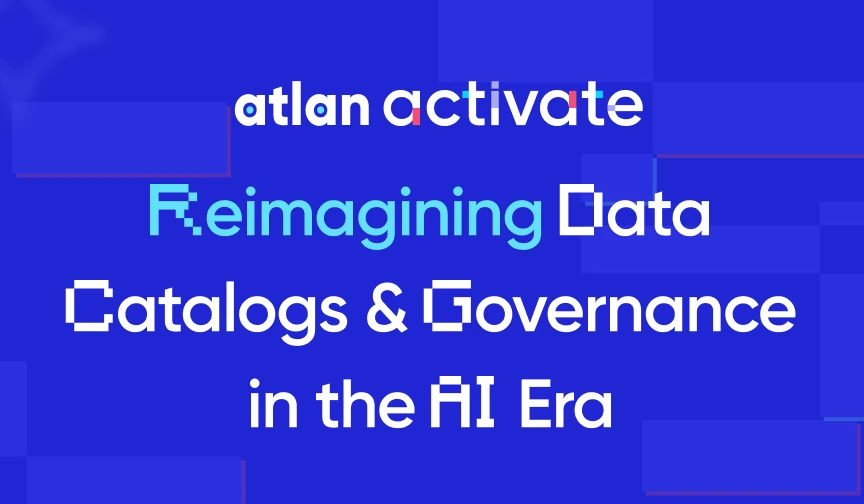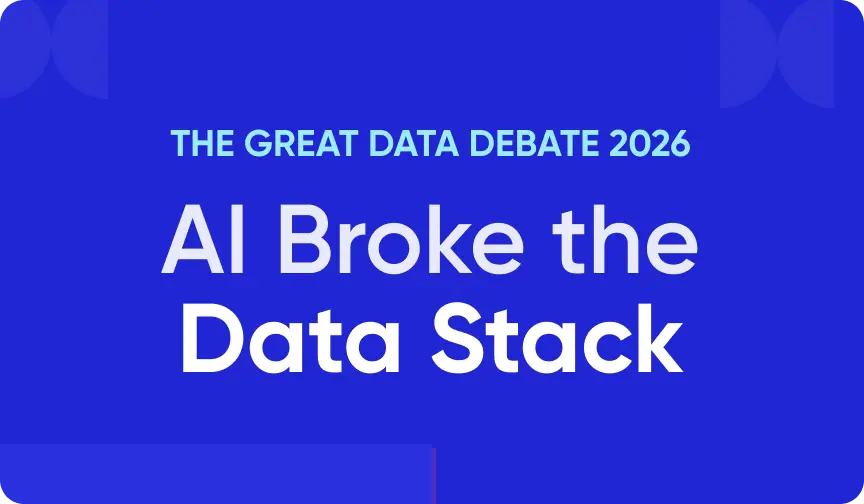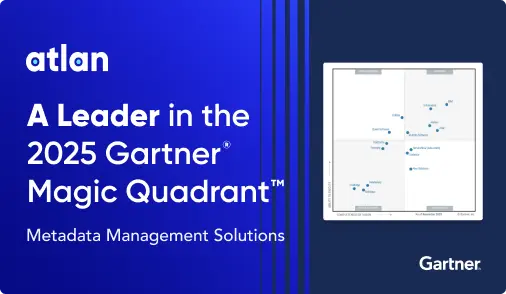How AI-Ready Data Lineage Activates Trust & Context in 2025
Why is AI-ready data lineage crucial?
Permalink to “Why is AI-ready data lineage crucial?”Summarize and analyze this article with 👉 🔮 Google AI Mode or 💬 ChatGPT or 🔍 Perplexity or 🤖 Claude or 🐦 Grok (X) .
As AI becomes a core part of the modern data stack, AI-ready data lineage enables you to adapt and leverage the latest developments in AI.
AI agents, especially those powered by generative AI and communication protocols like MCP (Model Context Protocol), ACP, and A2A, require rich metadata context to make accurate, safe, and meaningful decisions.
By integrating lineage with AI protocols like MCP (an open standard guiding how AI agents interact with external tools and data sources), organizations unlock immediate value through:
- Natural language interface to understand data assets, dependencies, and flows
- Intelligent search and discovery of data assets and their relationships
- Synchronization of technical and business context across pipeline changes
- Context propagation through upstream and downstream lineage for smarter automation
- Root-cause analysis and impact analysis of data changes
- Improved data quality and integrity by making anomalies and gaps traceable
- Increased explainability and interpretability of AI model decisions through lineage transparency
- Accelerated debugging and troubleshooting with full visibility into data transformations
- Activation of lineage metadata for for real-time governance, audit trails, and compliance enforcement
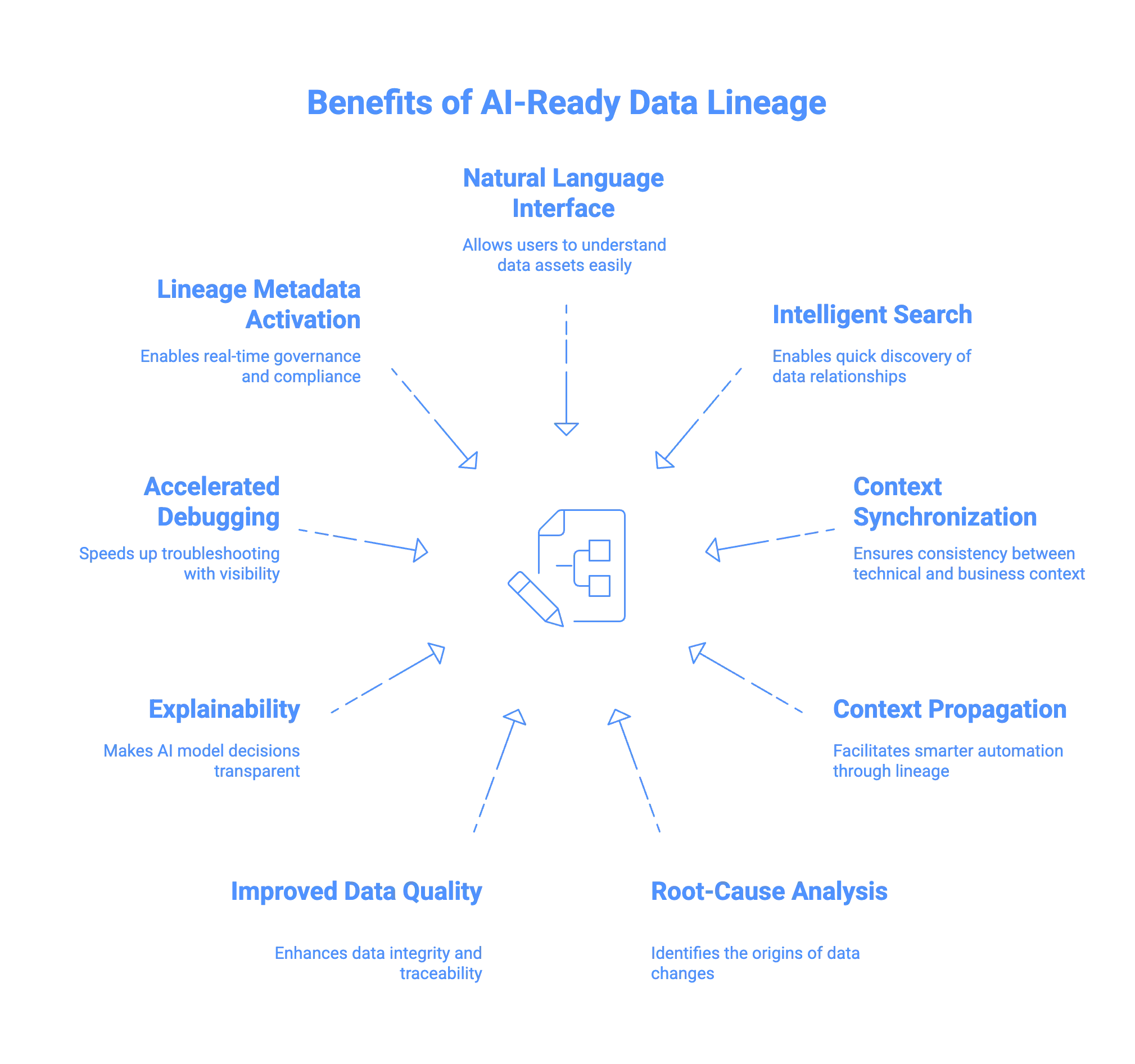
Benefits of AI-ready data lineage - Image by Atlan.
What are the top use cases of AI-ready data lineage?
Permalink to “What are the top use cases of AI-ready data lineage?”AI-ready data lineage drives important use cases, such as:
- Discovery and impact analysis by tracking Granular data flow and metadata changes
- Context that promotes better understanding of business metrics and KPIs
- Enhanced trust in data with the help of data quality metadata and logs
- Regulatory compliance with active, scalable data governance
How does AI-ready data lineage help with governance and compliance?
Permalink to “How does AI-ready data lineage help with governance and compliance?”Data lineage is key to answering questions from regulators enforcing rules on privacy, security, governance, and ethical data use.
Here are some of the questions that the data lineage metadata can help answer directly using a natural language interface:
- Where is a certain customer’s data stored in our organization? A Right to be Forgotten request has come through, and we need to address it.
- What were the decisions and data points that were used to reject a specific loan application in a bank? Was it due to certain bias in the AI model?
- What are the data points stored for any given patient in our hospital, and are any of those data points shared with third parties, such as insurance companies? If yes, which ones?
- Do any of our systems store credit or debit card details? If not, which third-party tools are used to save and retrieve payment information for our customers?
Bear in mind that answering the above questions is only possible if the data lineage metadata is AI-ready, i.e., is it readily available, is it accessible, and is it trustworthy. However, this is quite hard to realize without a viable and scalable long-term solution for data lineage.
Let’s explore these challenges further.
What are the biggest barriers to implementing AI-ready data lineage?
Permalink to “What are the biggest barriers to implementing AI-ready data lineage?”To make data lineage AI-ready, organizations will first need to make it available and accessible. Some of the biggest challenges include:
- Siloed metadata across tools, teams, and environments
- Inconsistent and non-standard lineage formats, making integration with AI protocols difficult
- Lack of tooling to activate lineage metadata for high-impact use cases like data quality, governance, and compliance
- Black box operators—such as opaque ML models, low-code tools, and proprietary systems—that make it hard to trace data transformations
- The growing complexity of modern data ecosystems, with multiple pipelines, hybrid cloud setups, and AI models layered on top of legacy systems
Without addressing these challenges, lineage data remains fragmented and unusable, limiting its value in both human-led and AI-assisted decision-making.
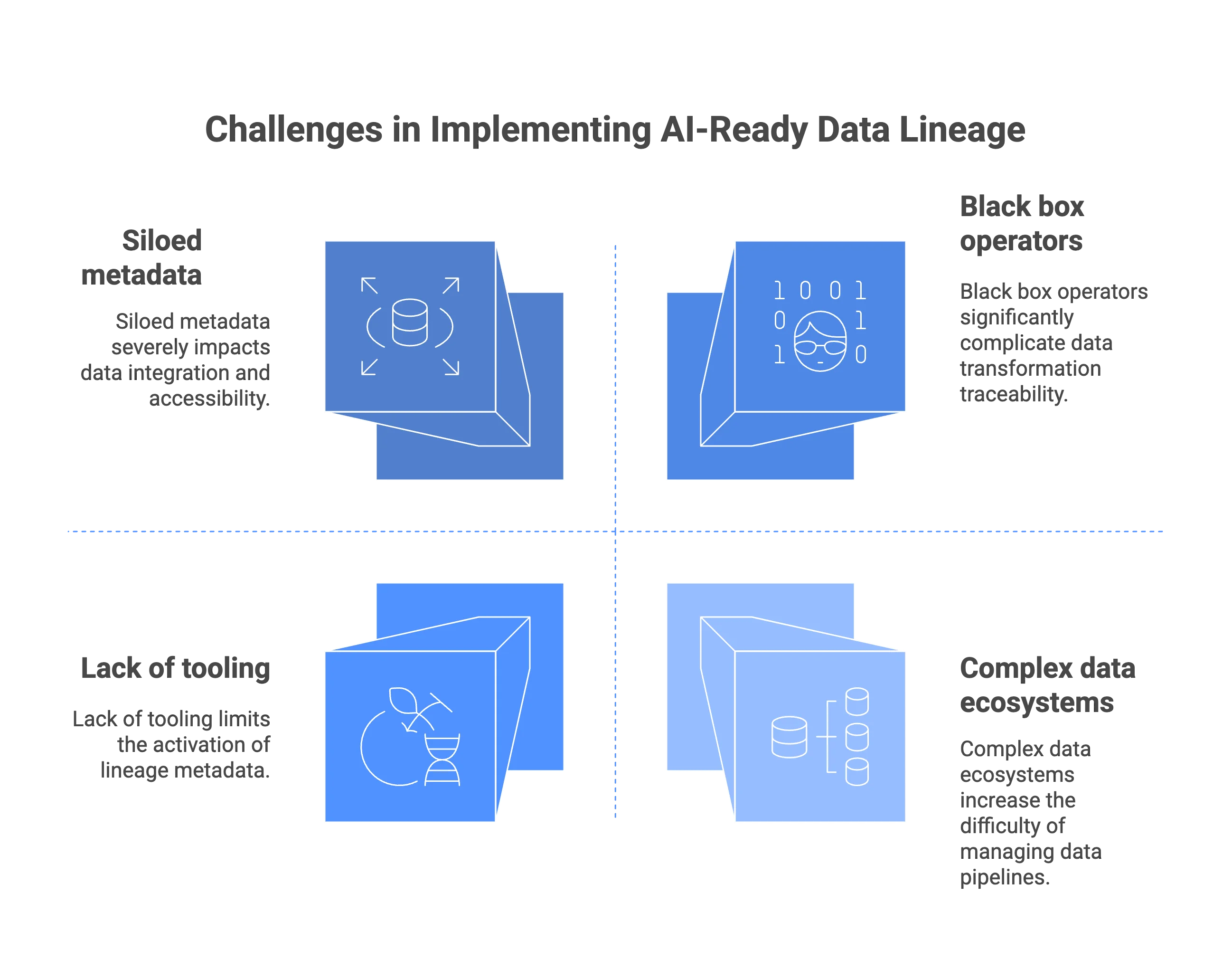
Biggest barriers to AI-ready data lineage - Image by Atlan.
The best way to tackle the above challenges and improve AI-readiness is by focusing on effective and active metadata management.
Let’s explore the role of metadata further in the next section.
What is the role of active metadata in AI-ready data lineage?
Permalink to “What is the role of active metadata in AI-ready data lineage?”Active metadata is the engine behind AI-ready data lineage.
Unlike static metadata, it continuously captures and updates information about data assets—their origins, transformations, relationships, and usage—across your organization’s entire data ecosystem.
This dynamic context is what makes lineage trustworthy, explainable, and usable by both humans and AI agents.
With the AI paradigm shift, getting metadata AI-ready is one of the big leaps that organizations need to take.
“If data isn’t contextualized, tagged or mastered properly, or if data lineage is broken, it’s bound to generate wrong predictions and drive the wrong decisions.” - Zakir Hussain, EY Americas Data Leader, on what it takes to get your data AI-ready
AI-ready metadata signifies its accessibility, reliability, and context-richness, enabling AI tools and technologies to enhance data discovery, governance, quality, and lineage.
And lineage is the connective tissue. It captures how data flows, evolves, and impacts downstream assets, giving teams a shared view into what’s happening, where, and why.
In addition to tracking the above information, active metadata also plays a key role in ensuring granularity of data lineage—tracking data at the column, process, or even query level.
How does granularity improve AI-readiness of lineage metadata?
Permalink to “How does granularity improve AI-readiness of lineage metadata?”Using AI systems means giving them as much context as possible about data relationships, dependencies, transformations, and lineage.
Tracking data flow and transformation across tables, views, materialized views, and other data assets changes isn’t enough to answer questions, such as:
- Discrepancy in business metrics: Why is the value of the LTV (Lifetime Value) of a customer different in the embedded report of my CDP and BI report generated using Tableau?
- Impact analysis: We’re thinking of changing how customer attribution is done. What impact will it have on downstream reports and dashboards?
- Logic calculation: Where does the actual calculation of the CAC (Customer Acquisition Cost) live? Is the calculation dependent on other metrics?
- Dependency tracking: Which data assets and pipelines am I dependent on if I want to create a new model for forecasting sales across regions?
To answer these questions, you need to have lineage metadata captured at a finer grain, i.e., at the column level, because that’s where all the real value of data is stored.
Granularity makes lineage precise enough for advanced AI use cases like intelligent alerting, automated impact analysis, or prompt engineering. Without it, lineage remains partial, brittle, and unusable at scale.
What are the key considerations to ensure AI-ready data lineage?
Permalink to “What are the key considerations to ensure AI-ready data lineage?”Six considerations are an essential prerequisite to ensuring AI-ready data lineage. These include:
- Standard, well-documented metadata capture and storage protocols and mechanisms
- A single place, where metadata siloed across systems comes together, to provide one true view of lineage
- Lineage change capture over time to explain and understand changes in downstream systems
- Granular, column-level tracking of metadata for tables, views, materialized views, and other data assets
- Extensive support for existing API-based communication for integration with other tools
- Exposability via newer tools and protocols, such as MCP (Model Context Protocol)
A key point that applies to all of the above is that the capture, maintenance, and availability of metadata should be at the same speed at which the actual data gets available.
Let’s see how a metadata control plane can solve this need.
Getting data lineage AI-ready with Atlan’s metadata control plane
Permalink to “Getting data lineage AI-ready with Atlan’s metadata control plane”A metadata lakehouse is an abstraction for a tool or a store of all of your organization’s metadata, which can then be activated or put to use for automation. This automation can be in the form of:
- Events
- Webhooks
- API calls
- Log entries
- Alerts
- Notifications
- Reports
- An interaction with an LLM (Large Language Model)
Atlan is one such tool that provides the foundation to activate metadata for key use cases like data lineage, quality, governance, and discovery.
Atlan helps you bring all metadata from various systems in your organization, often in siloes, in one harmonized format, which is ready to be consumed by other AI-based applications (like Claude Desktop and Cursor).
9 Atlan capabilities that drive AI-ready data lineage
Permalink to “9 Atlan capabilities that drive AI-ready data lineage”By activating metadata and data lineage, Atlan drives AI-readiness for your data team and AI agents. Its core capabilities supporting AI-ready data lineage include:
- Automated data discovery and mapping: Auto-detect data assets and relationships across platforms.
- Visual lineage: An interactive, intuitive view of data flows with personalized controls and filters.
- Actionable lineage: In-built actions–raise Jira tickets, trigger Slack discussions, alert downstream users–so that you don’t have to switch apps to collaborate.
- Automated SQL parsing: Understand column-level lineage directly from SQL queries.
- Code-level lineage tracking: Trace transformations across notebooks, dbt models, and more.
- Real-time anomaly detection and alerts: Identify and act on changes that affect lineage integrity.
- Audit trail for compliance: Maintain a record of lineage changes for regulatory review.
- Open APIs for endless extensibility: Seamlessly integrate with external tools and workflows.
- Out-of-the-box integrations: Connect with Snowflake, Redshift, BigQuery, Databricks, Tableau, and other data platforms in your data stack.
Real stories from real customers: Ensuring AI readiness in practice
Permalink to “Real stories from real customers: Ensuring AI readiness in practice”
Creating a Transparent Data Estate with Atlan
“Using Atlan’s automated lineage, we were able to see every existing connection in Fivetran. We could see what was actually used. As a result, we were able to deprecate half of their Snowflake tables, representing two-thirds of their data assets, and over 60% of their Looker assets.”
David Milosevic, Head of Data & Analytics
Mistertemp
🎧 Listen to podcast: Mistertemp’s data value journey
Discover how a modern data governance platform drives real results
Book a Personalized Demo →
Modernized data stack and launched new products faster while safeguarding sensitive data
“Austin Capital Bank has embraced Atlan as their Active Metadata Management solution to modernize their data stack and enhance data governance. Ian Bass, Head of Data & Analytics, highlighted, ‘We needed a tool for data governance… an interface built on top of Snowflake to easily see who has access to what.’ With Atlan, they launched new products with unprecedented speed while ensuring sensitive data is protected through advanced masking policies.”

Ian Bass, Head of Data & Analytics
Austin Capital Bank
🎧 Listen to podcast: Austin Capital Bank From Data Chaos to Data Confidence

53 % less engineering workload and 20 % higher data-user satisfaction
“Kiwi.com has transformed its data governance by consolidating thousands of data assets into 58 discoverable data products using Atlan. ‘Atlan reduced our central engineering workload by 53 % and improved data user satisfaction by 20 %,’ Kiwi.com shared. Atlan’s intuitive interface streamlines access to essential information like ownership, contracts, and data quality issues, driving efficient governance across teams.”
Data Team
Kiwi.com
🎧 Listen to podcast: How Kiwi.com Unified Its Stack with Atlan
Ready to start your journey toward AI-ready data lineage?
Permalink to “Ready to start your journey toward AI-ready data lineage?”Data lineage is more important than ever in the age of generative AI. These technologies open up powerful new use cases by making metadata more accessible—but they also heighten the risk of data misuse.
To be AI-ready, organizations need lineage not just to unlock value, but to protect themselves by meeting regulatory requirements.
Lineage ties all metadata together by capturing how data flows, transforms, and connects through your data estate. However, the AI-readiness of data lineage is hindered by the unavailability of all the metadata.
A unified control plane of data that gathers all the lineage metadata from everywhere else is a very good starting point for solving AI-readiness. It’s even better when that control plane also allows you to standardize how AI tools communicate and process information (using an MCP server, for instance).
Book a personalized demo to find out more about attaining AI-readiness using a unified metadata control plane and MCP.
FAQs about AI-ready data lineage
Permalink to “FAQs about AI-ready data lineage”1. What is AI-ready data lineage?
Permalink to “1. What is AI-ready data lineage?”AI-ready data lineage refers to metadata that’s complete, granular, and continuously updated—ready for both human use and AI systems. It provides the context AI agents need to understand, trace, and act on data across your ecosystem.
2. What makes data lineage AI-ready?
Permalink to “2. What makes data lineage AI-ready?”Data lineage can be considered AI-ready when it is in a position to be leveraged by AI tools for automation and exposure using the natural language interface. To do that, it must satisfy a few conditions first. It must be:
- Available, which means it exists in full and at a granular level,
- Accessible, which means that it is accessible using the desired AI tools, and
- Trustable, which means that you can use it to understand your data reliably
Attaining this state of AI-readiness is only possible when you have the right framework and the right set of tools to make the data available, accessible, and trustable.
3. Why does AI-ready data lineage matter today?
Permalink to “3. Why does AI-ready data lineage matter today?”With the rise of generative AI and autonomous agents, accurate metadata context is critical. AI-ready lineage improves trust in AI outputs, accelerates issue resolution, and ensures safe, compliant use of customer data.
4. What are some common use cases for AI-ready data lineage?
Permalink to “4. What are some common use cases for AI-ready data lineage?”Some very common use cases for AI-ready data lineage are:
- Intelligent data discovery
- Root cause analysis
- Data pipeline debugging and impact analysis
- Data flow mapping along with business context to trace the origin and calculation of metrics and KPIs
- Governance and compliance rule enforcement and automation using audit-based logging, propagation, etc.
- AI model explainability
5. What are the biggest challenges in implementing AI-ready data lineage?
Permalink to “5. What are the biggest challenges in implementing AI-ready data lineage?”Challenges include siloed metadata, lack of column-level granularity, black-box tools, inconsistent lineage formats, and growing complexity across cloud, on-prem, and AI pipelines.
6. How does Atlan support AI-ready data lineage?
Permalink to “6. How does Atlan support AI-ready data lineage?”Atlan offers a metadata control plane that unifies, activates, and operationalizes lineage metadata with features like automated mapping, visual lineage, anomaly alerts, SQL parsing, audit trails, and open APIs—making it fully AI-ready.
Share this article
Atlan is the next-generation platform for data and AI governance. It is a control plane that stitches together a business's disparate data infrastructure, cataloging and enriching data with business context and security.
AI-ready data lineage: Related reads
Permalink to “AI-ready data lineage: Related reads”- AI for Compliance Monitoring in Finance: Use Cases & Setup
- Unified Control Plane for Data: The Future of Data Cataloging
- Data Governance for AI: Challenges & Best Practices
- AI Governance: How to Mitigate Risks & Maximize Benefits
- The Future of AI Governance: Gartner’s Roadmap for Responsible AI Adoption
- 6 Essential AI Governance Principles for Responsible and Ethical AI Use
- What Is Data Lineage & Why Is It Important?
- Data Lineage 101: Importance, Use Cases, and Their Role in Governance
- 5 Types of Data Lineage: Understand All Ways to View Your Data
- 6 Benefits of Data Lineage with Insights Into How Businesses Are Leveraging It
- Automated Data Lineage: Making Lineage Work For Everyone
- Open Source Data Lineage Tools: 5 Popular to Consider in 2025
- Amundsen Data Lineage Setup with dbt
- Data lineage for Snowflake and BigQuery
- Data Catalog: Does Your Business Really Need One?
- Data Catalog vs. Data Lineage: Differences, Use Cases, and Evolution of Available Solutions

